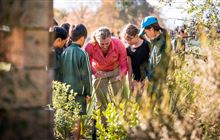Nature journalist
Introduction
Write a current event or news article inspired by nature.View and download the activity in English or Te Reo Māori.
Nature journalist – Report on nature
Nature journalist activity card (PDF, 849K)
Students will need
A camera, iPad and/or artwork.
Activity
Story ideas or angle
What’s the current event or news article you want to write? Is it:
- an opinion piece (like an editorial)
- a feature article (longer and more in-depth than a regular news article)
- a report on a nature project
- a story, eg a day in the life of a tree/bird/insect
- a fact sheet.
Interview questions
For people or nature itself – get creative, what did the tree see, hear, feel?
Drafting your story
You will need:
- Opening paragraph (sometimes written in bold font)
- Tell the reader the key details of the story (who, what, when, where).
- Quotes – from your interview(s) to help tell the story.
- These are the exact words spoken by the person you interviewed. Remember to use speech marks.
- Conclusion – sum up the story and leave the reader with something to think about.
- A headline (and sub-heading) – to attract the reader’s attention and make them want to read the story.
- Make it short and snappy. Funny. Dramatic.
- An image – photo, illustration or artwork – a picture tells a thousand words!
- A caption for your image – what’s the image of?
- Publishing – where will your readers find your article?
- School/class newsletter? Website? Blog?
Extension ideas
- A class newspaper – what would you call your class newspaper?
- Collate your stories into one publication.
- Film your class news and create a ‘bulletin’
- Tell your different stories all at once.
Kairipōata taiao – Pūrongo o te taiao
Rauemi tauira
Kāmera, īpapa, he pukatoi rānei.
Papamahi
Whakaaro/aronga
He aha tētahi kaupapa o te wā, pūrongo o te wā hei kaupapa tuhi māu?
- He aha te tūmomo pūrongo, he pūrongo whai whakaaro na tētahi? He pūrongo taiea rānei?
- tuhi pūrongo mō tētahi tūāhuatanga taiao
- te rā o te ao o tētahi rākau/manu/ngārara,
- he hīti whai take.
Uiuinga tāngata, taiao rānei
Kia auaha ngā pātai, i kite, i pā, i rongo aha te rākau?
Tuhinga hukihuki – me;
- He tuhinga taki (ētahi wā kua tuhia ki ngā momotuhi pākaha)
- Whakiia ki te kaipānui ngā tūāhuatanga whai kiko (kōwai, he aha, inahea, kei hea)
- Whakatauāki – nō āu uiuitanga hei whakamārama i te korero/pūrākau.
- He korero pono nō te kaiuiui ki a koe)
- Whakarāpopototanga – hei whakakapi i te pūrākau, ka whakatō ake he whakaaro ki te kaipānui.
- Ūpoko matua (tuaruatanga rānei) – hei whakatenatena i te kaipānui e hiahia ana rātau ki te pānui i āu korero.
- Kia poto kia ita, kia hātakehi kia pīkarikari.
- He pikitia – mahinga toi he nui ōna kōrero.
- He tapanga mō te pikitia, he aha taua pikitia?
- Perehi – me tirohia e ngā kaipānui tāu pūrngo kīhea?
- Kura/nūpepa ā-akomanga? Paetukutuku? Rangitaki?
Toronga whakamua
He nūpepa ā-akomanga – he aha he īngoa pai mō te nūpepa ā-akomanga?
- Kohikohia āu tuhinga pūrongo
Hanga kiriata o tōu akomanga e pūrongo ana.
- Whākiia āu pūrākau rerekē i te wā kotahi.



